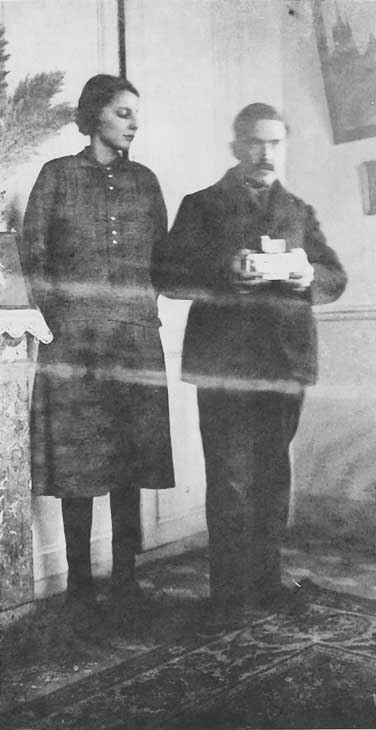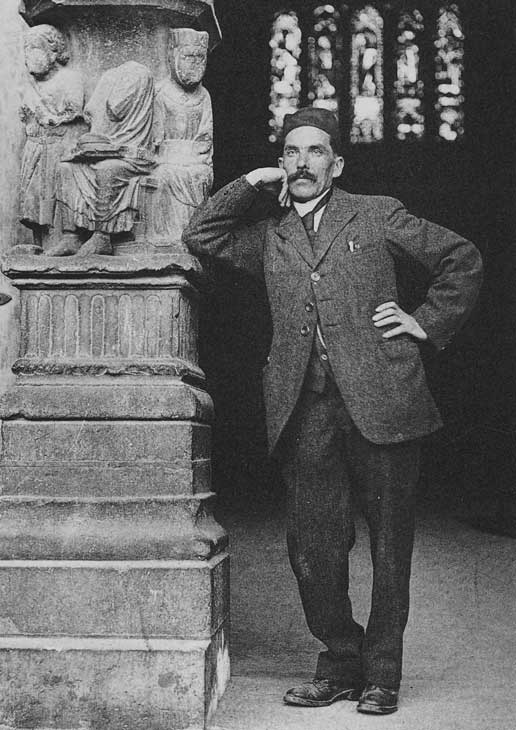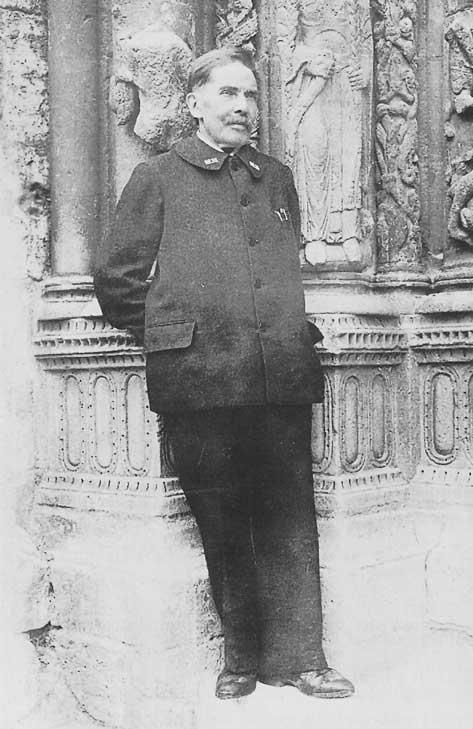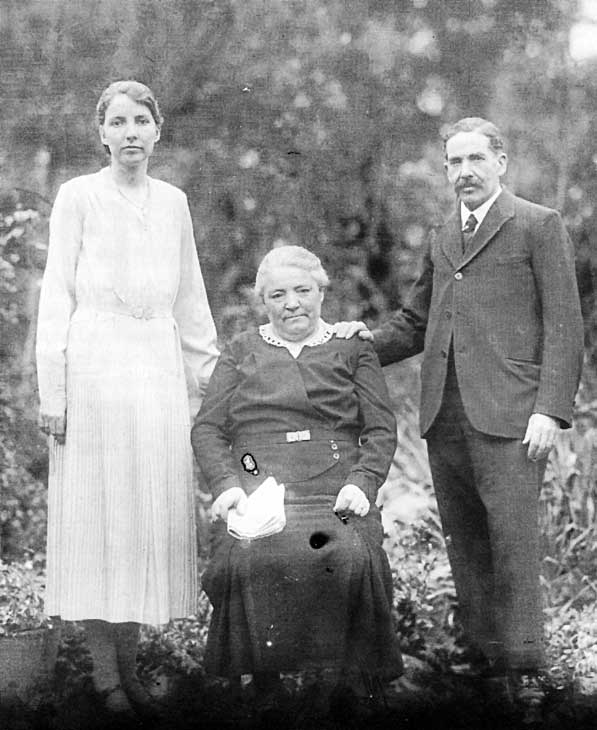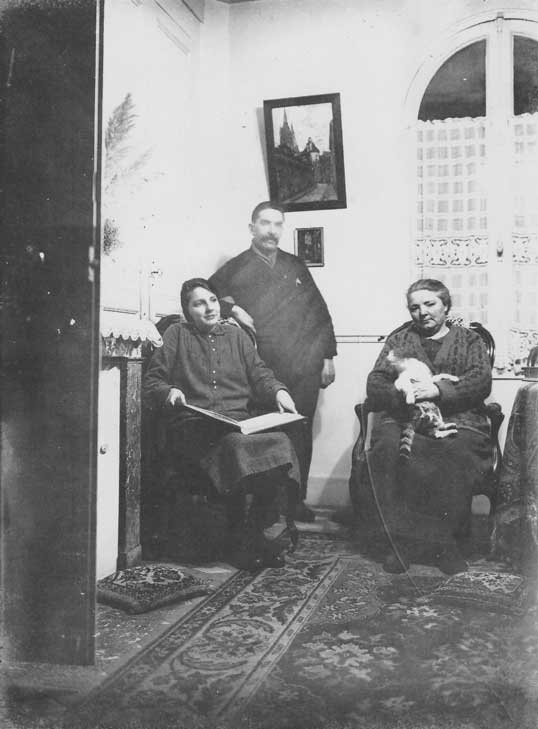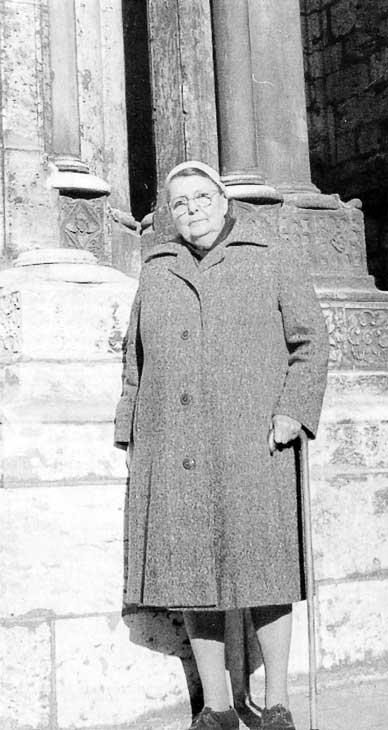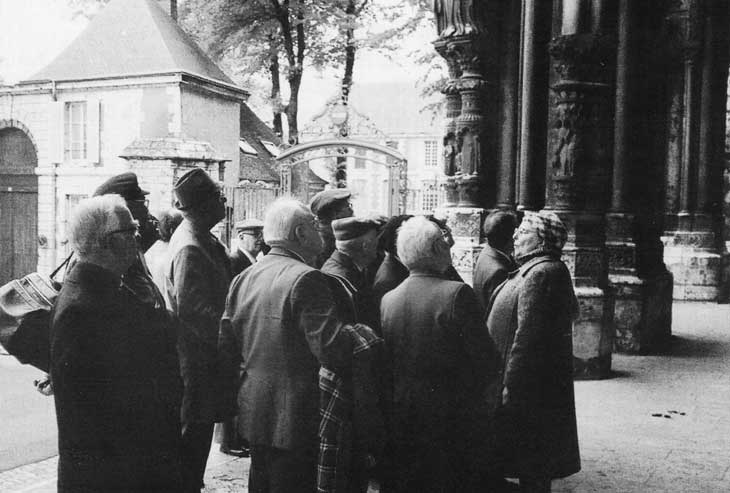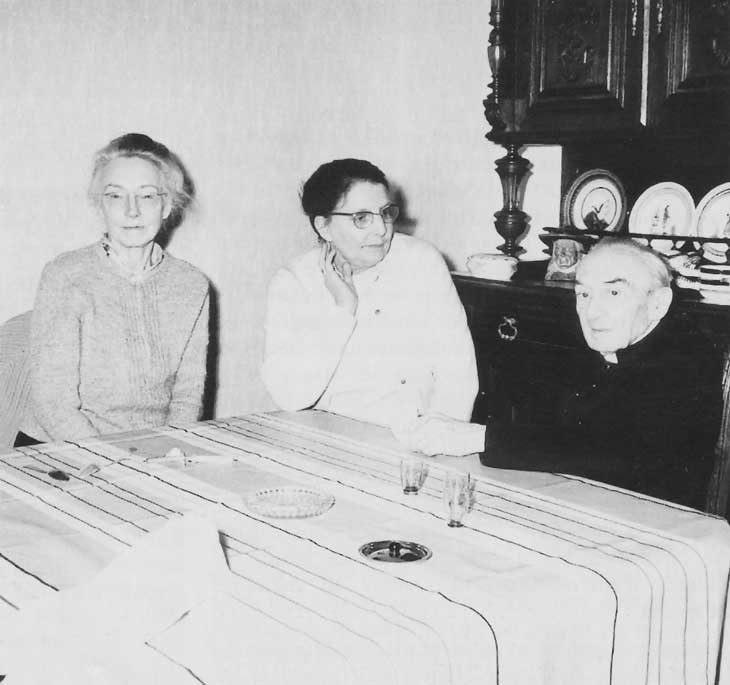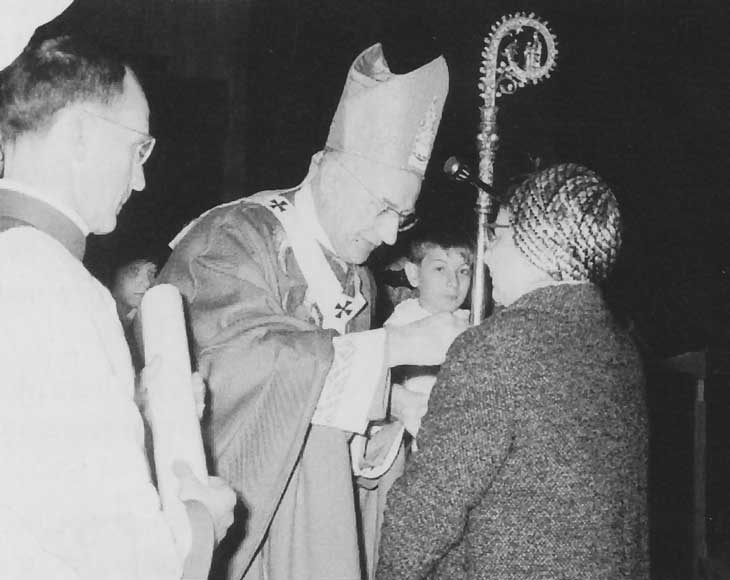Looking back on the life of Étienne Houvet: Marie Houvet, remembering…
From the publication “Étienne and Marie Houvet, Chantres de Notre-Dame”.
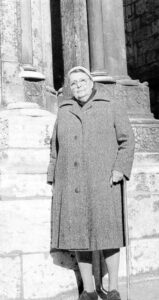 According to the adage: like father like son, to understand the life of Mademoiselle Marie Houvet, her artistic qualities and her mission at Chartres Cathedral, it is first necessary to look at the life and work of her father: Mr. Étienne Houvet.
According to the adage: like father like son, to understand the life of Mademoiselle Marie Houvet, her artistic qualities and her mission at Chartres Cathedral, it is first necessary to look at the life and work of her father: Mr. Étienne Houvet.
Born in Cercottes (Loiret) on June 18, 1868, nothing seemed to predispose Étienne Houvet to become the famous cathedral guide. Married to Marie, Yvonne Thomas, he agreed at the age of 29 to become sacristan of the cathedral to better support his elderly parents.
For nine years, he quietly carried out his duties. But as he watched over the oil lamps in the crypt, his contemplative soul slowly became imbued with the incomparable glory of the sanctuary.
As a guide to the cathedral, he saw that many visitors had difficulty discovering the marvellously painted scenes in the high windows, and so he had the ingenious idea of bringing them within everyone’s reach, thanks to photography. He built himself the rolling wooden tower that enabled him to take the pictures under the best possible conditions, which he then developed himself.
And it was Canon Delaporte who taught him an original way of taking photographs, by applying a sensitive plate directly to the stained glass. This proved to be a great success: he published several monographs on the cathedral, highlighting both the dazzling stained-glass windows and the admirable sculptures created by medieval artists.
Expertly advised and assisted by Canon Delaporte, the photos were magnificently accompanied by texts that allowed readers to enter the mysteries of Chartres’ treasures.
But above all, Étienne Houvet, as a guide, was an ever-growing success with his visitors, whether humble or learned, as evidenced by the words of high regard addressed to his daughter, Marie Houvet, after her father’s death on April 25, 1949.
Mr. Houvet drew his inspiration from prayer, the rosary in particular.
In their daily meditation before the Blessed Sacrament on the altar, many bishops, abbots, priests, religious and visitors from all over France and abroad paid tribute to Mr. Houvet; the French Republic also honored him during his lifetime, awarding him the rank of Chevalier in the Order of the Legion of Honor.
So it’s hardly surprising that his daughter, Mlle Marie Houvet, was a worthy successor to her father.
And yet, at first, she didn’t seem destined for such a vocation. Until the age of fifteen, Marie lived peacefully in the home of Étienne and her mother, Yvonne, at 25, rue de Rechèvres, Chartres. She often plays in the family garden, from which there is an unobstructed view of the cathedral. According to her correspondence, she led a mediocre Christian life. But at the age of fifteen, her desire for union with God through love grew, and the prospect of a religious missionary life was born in her heart.
Let’s not forget that, as a child, her father had wanted to be a Dominican friar, but in order to support his needy parents, he had renounced this first vocation.
Until the age of 27, Marie worked intensely in the parish works of the cathedral, sometimes even to the detriment of her health. Her father would have liked to associate her with his mission at the cathedral, but she had no attraction in that direction.
In 1937, a lukewarm mood invaded her soul, no doubt because she was too active in the outside world.
In 1939 (she was 25), doctors declared her suffering from pulmonary tuberculosis.
This illness, and the death of a child she loved dearly, gave her an electric shock. She promised to unite herself with Jesus and give herself to souls.
She decided to assist her father as a guide at the cathedral. As her father had done in his youth, she studied Émile Mâle’s works on the sanctuary and Gothic art in general. She asked many questions of the great specialist on our cathedral, Canon Delaporte; above all, she followed in the footsteps of her revered father, whose reputation was at its peak.
Parallel to this intellectual and artistic activity, she made a vow in 1943, on December 8 to be precise, to be the servant of Notre-Dame at the cathedral.
Her spiritual father was the revered Monsignor Boucher, vicar general of Monsignor Harscouët, national president of Marian works!
Under the guidance of such a master, she drew up a set of rules for her spiritual life, which would become the soul of her pastoral activities.
These rules were inspired by the spirituality of the Daughters of Saint Francis de Sales, to whom she had just joined:
– Morning meditation prayer,
– Mass or visit to the Blessed Sacrament,
– Spiritual reading after lunch,
– Visit to the Blessed Sacrament in the evening.
Didn’t her father himself alternate his day between prayer and guided visits?
Her father, we recall, wore a penitential cilice on certain days.
Marie asked her spiritual father if she could wear it from time to time. Monsignor Boucher categorically refused. “Be faithful to the little things of daily life, and entrust yourself to the admirable Mother”, he wrote to her. Wise advice indeed, which Marie scrupulously observed.
In 1949, as we have seen, Marie was saddened by the loss of her father, to whom the ecclesiastical community of Chartres and his listeners around the world paid a vibrant tribute.
At her request, supported by the ecclesiastical authorities, the Ministry of Fine Arts granted her, like her father, the title of official guide to historic monuments, with the obligation of giving one or two guided lectures a day.
In fact, in addition to these official lectures, she made several visits to special groups, which constituted a veritable catechism and gave her heart a feast.
What a joy it was, in fact, to have these images painted in the stained-glass windows speak for themselves, these marvelous sculptures recounting the life of Jesus, prepared by scenes from the Old Testament (especially in the north portal), unfurled in the royal portal and continued by the lives of the saints in the south portal.
She usually presented them with her back to the stage, letting her knowledge, heart and faith speak for themselves.
She spoke of them with such precision, life, flame and love that she captivated her audience and made them want to continue their visit again and again, to the point where she was often exhausted.
Fortunately, Marie knew how to surround herself with a team of auxiliary guides who supported her marvelously in her work. This team, along with Canon Delaporte, who was still alive until 1979, advised her effectively on the continuation of the Houvet publishing house and the management of the cathedral souvenir store, authorized by the clergy first in the Saint Piat chapel, then at the back of the cathedral where it now stands.
Appointed parish priest of the cathedral by Monsignor Kuehn in 1979, a few months after Canon Delaporte’s death, I soon came to appreciate the pastoral work of Marie Houvet and her team, and befriended them.
Her health had always been weakened by the illness that struck her when she was twenty-five, and she was quick to say to me: “Father, we need to think about the next generation. I won’t be able to stay at the head of this work much longer, so find me someone I can train.”
So, having learned that one of Kermaria’s sisters had studied at the Beaux-Arts and was about to finish her retraining year, I took up my pilgrim’s staff and went to find her provincial in Rennes.
“In Chartres,” I told her, “there’s a remarkable evangelizing mission for a sister, thanks to the visits to the cathedral. I know that Sister Anne-Marie will soon be available. Can you send her to us for this mission?”
“Our next council will consider this proposal,” Sister Annick replied.
And a few weeks later, I had the joy of receiving her in Chartres, to fine-tune the project.
I finally received an affirmative answer in June 1981, which filled dear Marie Houvet with joy. She was ready to sing with Simeon her “Nunc dimittis , now I can go”.
There was first a “handover” between her and Sister Anne-Marie. Then Marie Houvet, growing increasingly tired, gradually stepped aside.
It was not without a certain bitterness, even suffering, that Marie gave way, so much had “her cathedral”, as she called it, invaded her whole life. But she made the sacrifice inwardly and generously for the continuation of the work.
On the morning of September 14, 1989, I was surprised to receive a phone call from Bruno, her neighbor: “Come quickly, Miss Houvet died last night”.
I hurried to her home and could only observe the painful reality.
Marie, in her sleep, had passed from this earth to the glory of heaven; she was to sing the Lord’s praises with the elders of the apocalypse, accompanied by the musicians she had so often contemplated in the cathedral’s south rose window.
Her funeral was held in the cathedral she had so admired during her visits, and in which she had prayed so much; it was presided over by Monseigneur Kuehn, Bishop of Chartres, in the presence of numerous priests and a crowd of faithful and former listeners attentive to the words pronounced that day.
Bishop Kuehn: “Mademoiselle Houvet,” he said, “devoted her life to the service of the Lord, with a tender attachment to the Blessed Virgin, her patron saint. Her cathedral was the place of her prayer and of her aesthetic and spiritual joys, and it was also the place of her service to her neighbor.”
As parish priest of the cathedral, I continued: “The source of your mission is to be found in this passage from your spiritual notes.” “Providentially chosen to be the happy little handmaid of the handmaid of the Lord, I want to see everything in the sole light of divine love, to undertake everything out of love, under the guidance and with the maternal help of Mary”.
“Your mission,” I added, “you have lived it as a vocation, almost a priesthood. This is what fueled your life lived in faith, humility, poverty, an exquisite charity that put you spontaneously in touch with others, never judging people, excusing everything, trusting in everything. Dear Mary, may the Lord grant us to follow in your footsteps during our earthly pilgrimage, so that we in turn may be servants of the Handmaid of the Lord, to join you one day in this house of God, of which our cathedral in all its splendor is but a small reflection of its infinite beauty”.
As the procession made its way down the nave of the cathedral to the Saint-Chéron cemetery, the sun flooded the stained glass window of the Pascal Mystery. Contemplating the image of the crucifixion, then the transfiguration, all haloed, and the appearance of the Risen Christ to the holy women, I couldn’t help but murmur to Mary: “Christ had to suffer to enter into his glory”.
“Mary, to accomplish your mission at the Cathedral, you have had to give up many childhood relationships, you have had to interrupt friendly relations, you have suffered, but today you are going to enjoy the glory of the Risen One. Enter into his joy.”
And now, from heaven, Mary must rejoice greatly to see that the visitation service created by her father, continued by her care, has not only not perished but has developed wonderfully.
First of all, Sister Anne-Marie, with her artistic competence, her vast culture and her enthusiasm, not only continued Marie Houvet’s mission, but took it to a high degree of perfection, creating a reception area and temporary exhibitions in the cathedral.
After his departure, Madame Deboos took over, surrounded by a team whose competence is matched only by their dedication.
Thank you Étienne, thank you Marie, for giving the initial impetus to a service that produces such delicious fruit for the joy of listeners and the glory of Notre-Dame.
Our Lady, represented 175 times in our cathedral, always carries her blessed Son on her lap and seems to say to us, as at Cana: “Do whatever he tells you.”
Father Joseph Hercouët †
Titular Canon of the Cathedral
Director of diocesan pilgrimages
